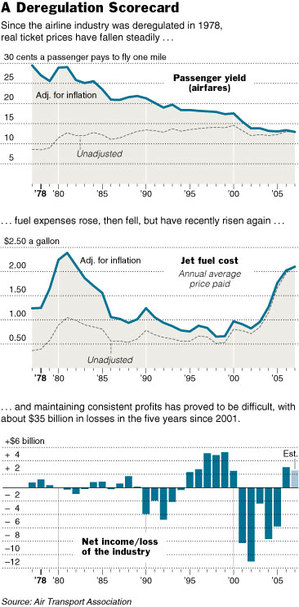Source of graphic: online version of the NYT column quoted and cited below.
The top graph above usefully summarizes one of the main results of airline deregulation–lower fares. Other results are sketched below in a couple of passages from a Leonhardt column.
(p. C8) Flying is less expensive, as fares have fallen steadily, adjusted for inflation, and there are more flights to more cities. The barrier to entry is lower. Over the last 30 years, more than 150 airlines have sought bankruptcy protection or disappeared, but more keep springing up as investors continue to put hope over experience, said Denis O’Connor, managing director with AlixPartners, a restructuring firm.
“People don’t understand how easy it is to start an airline,” Mr. O’Connor said, because of a ready supply of pilots and other employees, as well as used airplanes. “Why would you put capital in something if you can’t make a go of it? Southwest is an example of why you would.”
. . .
. . . Southwest’s transformation from a Texas puddle jumper to the biggest airline in terms of domestic traffic (at least until the Delta-Northwest merger is completed) would not have happened without deregulation.
That airline’s evolution is what some experts point to as the best proof of why deregulation, for all its troubles, ultimately is better than a regulated environment.
“This is the free market at work, and we’re not used to it,” said Mo Garfinkle, a lawyer and a longtime airline industry consultant. “The idea of deregulation was to allow entry, whether it was successful or not.”
For the full commentary, see:
MICHELINE MAYNARD. “Did Ending Regulation Help Fliers?” The New York Times (Thurs., April 17, 2008): C1 & C8.
(Note: ellipses added.)


